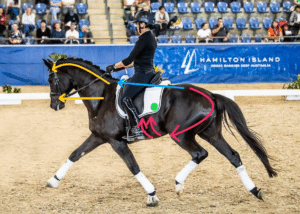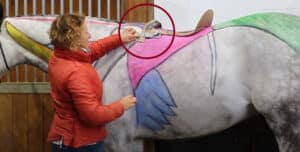The Link Between Pressure And Movement
The fit of your horse’s saddle and the way they move are related. But what does that mean? SMS Qualified Fitter PAULA JEFFERY explains.
We talk a lot about how the biomechanics of the horse (the way they move) is affected by saddlefit, either in a positive or negative way. But what does that actually mean from an owner’s perspective?
A great place to start is to understand the role muscles play in moving your horse’s bones. The muscles in their back, shoulders, hindquarters and neck control the movement of their front legs and hind legs, as well as the way their back and ribcage swing and lift. By nature, horses are built to move efficiently in a certain pattern to get themselves about in different paces and speeds, while stopping, turning and balancing. When they are able to move freely, they limit injury to their muscles and joints.
When we place pressure on muscles, as we do when we put a saddle with a rider’s weight on our horse’s back, we have an impact on how well the muscles can do their job of moving those limbs. As the pressure increases, so does the impact on the muscle; we can restrict blood flow and oxygen, damage muscle fibres and nerves, increase muscle fatigue, and stop the muscle functioning efficiently and at its full capacity.

When we do this, we stop the muscle from moving the limb and joints in their full range of motion – so stride length, shoulder rotation, back lift and swing, can all be affected. As well as the direct impact on muscle function, we also have a pressure/pain reaction from our horse. Their tendency, just like ours, is to move away from pressure or pain, so they change their posture or movement in an automatic response to avoiding it.
How do we know?
How do we recognise when our saddle is having a detrimental effect on our horse? On a day-to-day basis, are there things we can look out for as owners and riders? And what long-term implications should we be concerned about?
Firstly, there are the obvious extreme behavioural reactions – such as bucking, pinning the ears back when girthing, and moving away when the saddle comes out – that hopefully most of us are now recognising as discomfort, not just attributing it to the horse ‘being difficult’.
But there are many more postural, muscular, and movement issues created by high pressure from incorrectly fitting saddles that have both short-term impacts on the horse’s ability to do their job, and long-term implications for their soundness, increased susceptibility to injury, decreased level of performance, and happiness.
Science is now leading the charge in analysing exactly what is happening underneath a saddle. Current research has well and truly established that increased pressure from saddles can shorten the horse’s stride length, limb rotation and efficiency, decrease the range of motion in the horse’s back, and cause the horse to change their posture under the weight of a rider.
These studies help us understand why we need to take a closer look at the way saddles are designed and how important it is to fit for each horse’s unique conformation and muscular development in order to distribute the rider’s weight correctly and limit the impact on the horse’s movement.
One staggering finding from recent studies measuring the force transmitted onto a computerised pressure mat under the saddle, was that in trot the force impact is twice the rider’s weight, and in canter it’s two and a half times the rider’s weight!
Now, that is a big enough fact to swallow if we are considering an exceptionally well-fitted saddle, with a well-muscled horse and balanced rider – but what happens when the saddle’s gullet plate is too tight, or the balance is more rearward, or the rider sits a little crooked? What if the flocking is lumpy, the channel too narrow or the shoulder panels too full? Suddenly, instead of that two and a half times force impact being distributed evenly over the horse’s back, it’s creating even higher peak pressures on muscles and joints in the areas where the saddle is not fitting correctly.
Follow the clues
Whilst all this might seem a bit gloomy, the impacts of pressure leave clues! When you know what to look for, it is much easier to recognise the signs indicating that your saddle needs adjustment or re-fitting by a qualified fitter.
So, what are some of the primary areas of high pressure that we see and what are some of their impacts on posture and biomechanics?
Below are some of the reasons for high pressure and the symptoms that can be a good indication that your horse is having difficulty with moving under saddle in an easy and comfortable way.
Learning to recognise and act on these symptoms early by calling in a professional to help you with your horse is the best way to minimise long-term effects on their comfort and soundness, and to ensure that you have many years to come enjoying your time with a willing and happy partner!

Areas of high pressure under the front of the tree: Tree width across shoulders, tree leg length, gullet angle, first girth point, stirrup bar
The front of the saddle
Some of the reasons for increased pressure in the front of the saddle include:
- Gullet the wrong size (too narrow or too wide)
- Too narrow a tree for the width of the horse’s shoulders
- Panels sitting too high in channel
- Saddle sitting too far forward or slipping forward in movement
- Channel too narrow
- Saddle tilting forward into wither pockets
- Shoulder panels of the saddle restricting shoulder rotation
- Not allowing for asymmetric shoulders
- Not enough clearance over the top of the wither
Symptoms you might notice:
- Your horse having difficulty being on the bit, carrying their head and neck high
- Inconsistency in the rein contact or ‘bracing’ against the bit
- Throwing their head up in transitions
- Stumbling or tripping in their front legs
- Girthy when tightening the girth
- Difficulty bending or turning in one direction more than the other
- Refusing jumps
- Dropping jump rails with their front legs or ‘dangling a leg’ over a jump
- Throwing their head up on landing and racing off
The Back of the Saddle
Some of the reasons for increased pressure in the back of the saddle include:
- Seat balance being too rearward into the cantle
- Saddle tilting backwards
- Flocking under the cantle too hard
- Channel at the cantle being too narrow for the spine
- Saddle being too long/past T18 or the last rib
- Saddle ‘bouncing’ at the cantle especially in trot
- Panel shape incorrect for back shape e.g. panel angle too steep for a flat back
- Saddle slipping to one side at cantle
- Rider in a chair seat
Symptoms you might notice:
- Horse is ‘lazy’ and hard to push forward
- Dragging hind toes in walk and trot
- Under tracking with hind feet in trot
- ‘Plaiting’ movement with hind legs
- Swinging hindquarters out on circles rather than bending
- Dropping in the lower back or tilting pelvis forward when mounted
- Knocking jump rails with hind legs
- Bucking on landing after a jump
- Difficulty striking off into canter
- Hopping into trot transitions
Visit Paula and her team at Performance Saddlefits.



